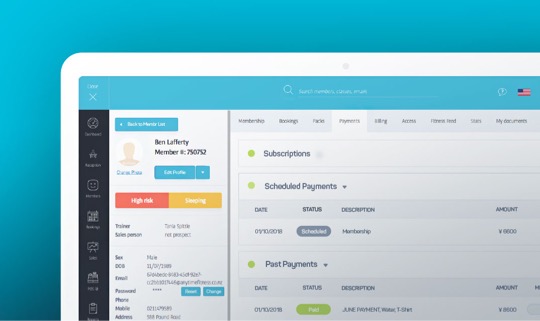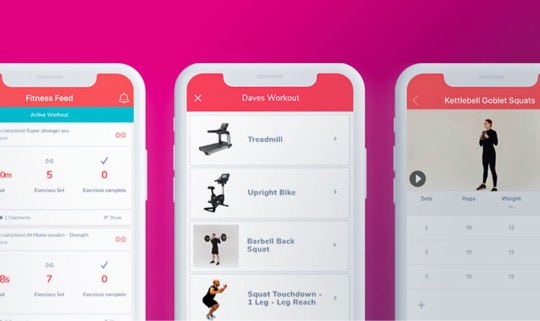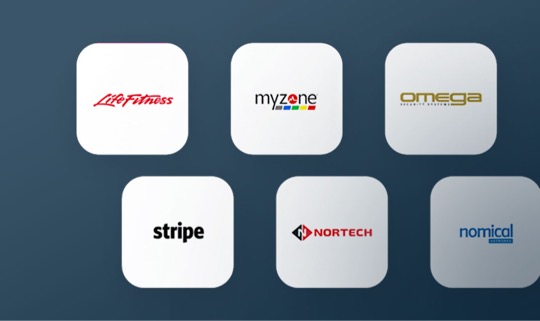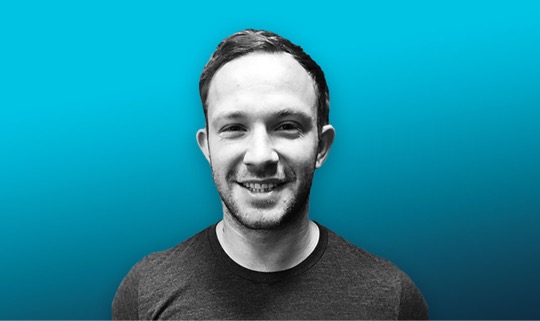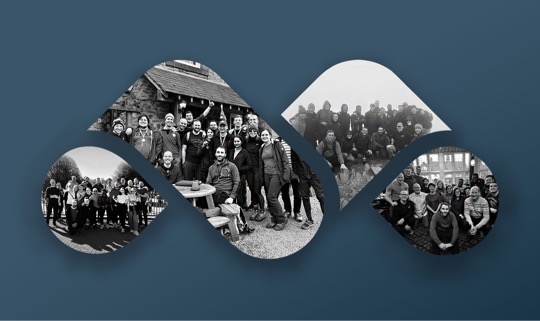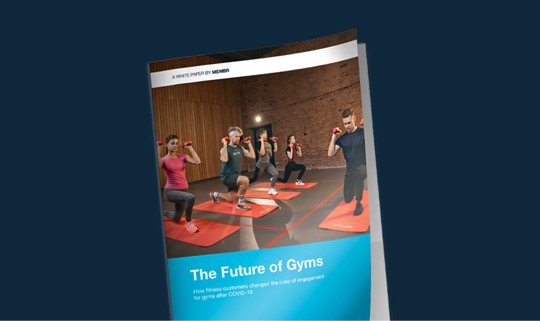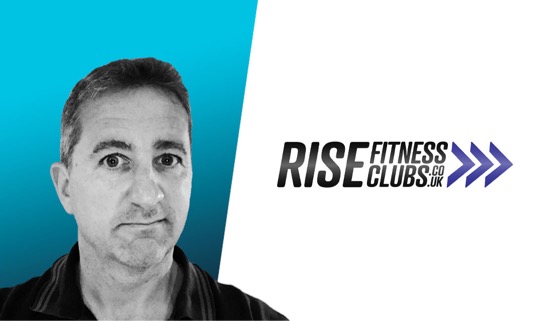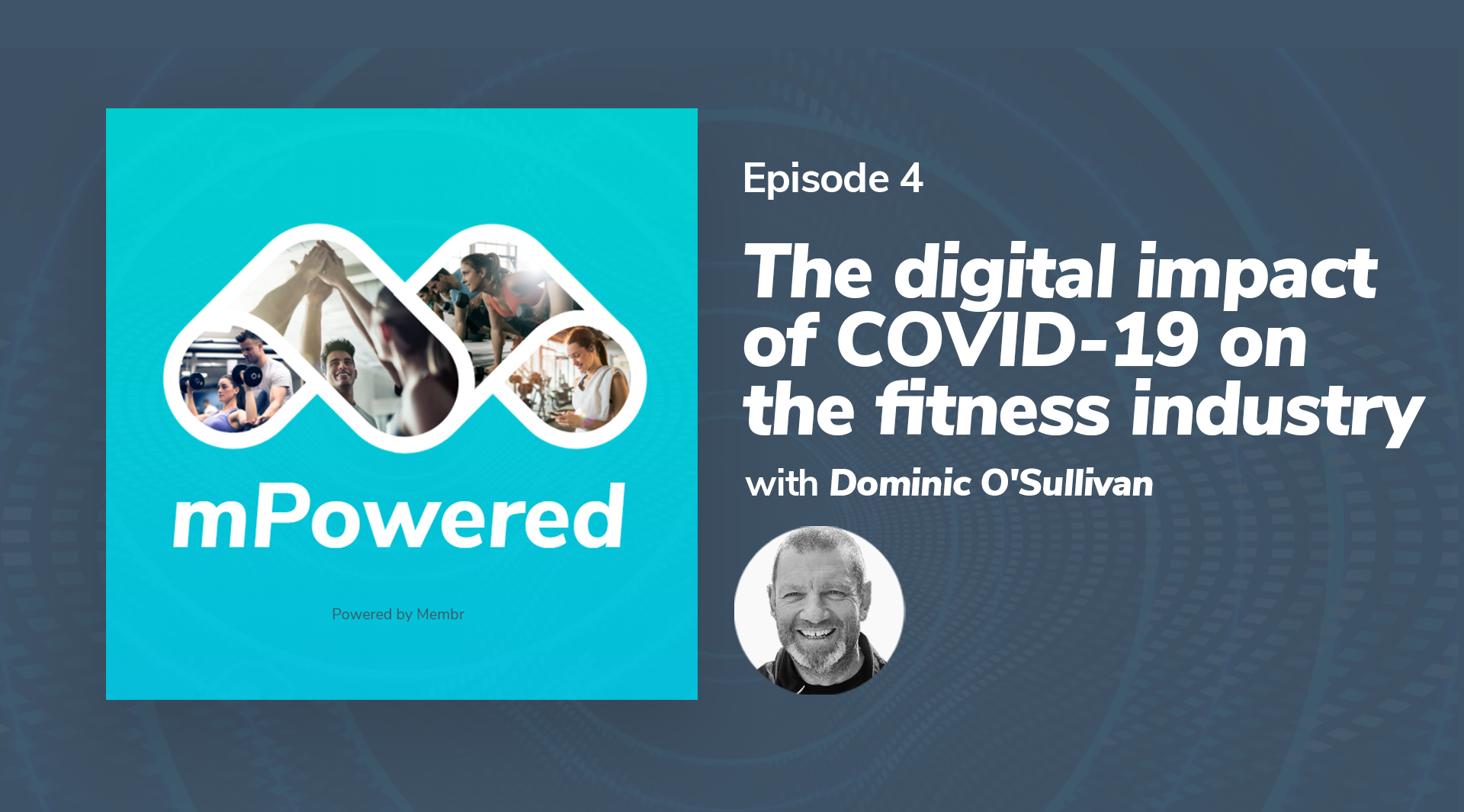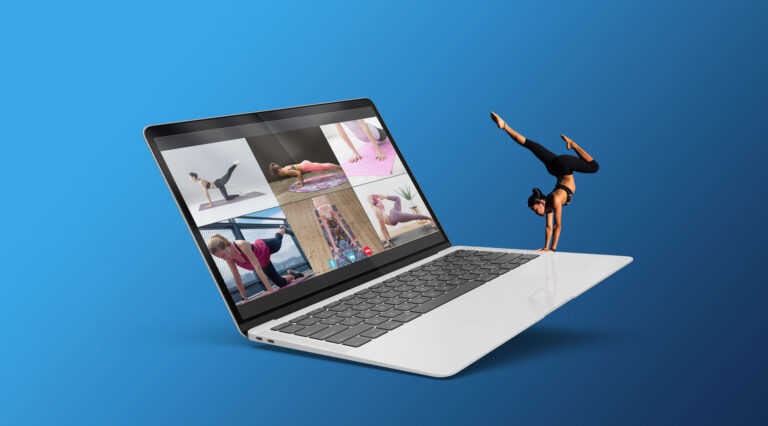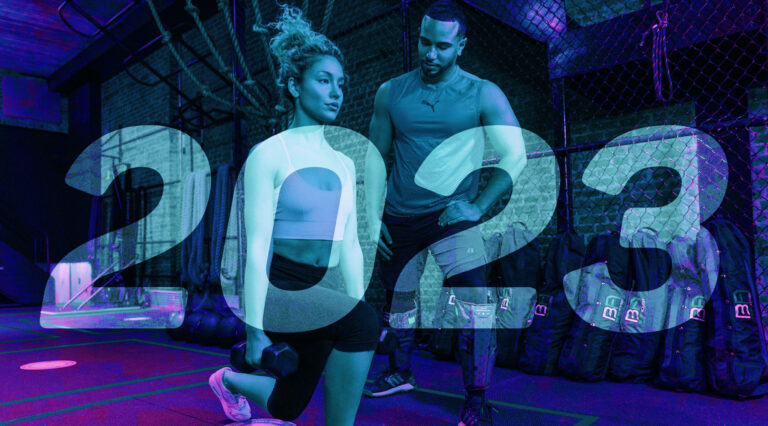Dominic O’Sullivan 0:01
This year, more than any year, I think the industry has seen more change and learned probably a lot more about itself than any other year. I just think this has been a real accelerated learn for a lot of people. I’ve seen a lot of action from operators, not all of it planned particularly well, some of it very reactive. I think some of the things that they’ve they’ve done, have been forced upon them rather than kind of voluntary decisions at times. And I think other operators have sort of sat there and just prayed to the gym gods and hoping that things will just go back to normal.
Craig McNeill 0:40
Welcome to mPowered. I’m Craig McNeill, and I’ll be your host. What does the future of the traditional gym look like? Can gym owners learn about brand loyalty from social media. How do you keep exercisers engaged during a global pandemic? We started mPowered with a mission to answer those questions and more. Join us for conversations with global health and tech experts around the changes and challenges within the fitness industry, for groundbreaking leadership ideas, and the latest fit tech innovations.
Craig McNeill 1:18
Welcome to mPowered. And I’m pleased to say that I’m joined by Dominic O’Sullivan, today. Hi, Don.
Dominic O’Sullivan 1:24
Morning, Craig!
Craig McNeill 1:25
How are you, buddy?
Dominic O’Sullivan 1:27
I’m good, thank you. I’m good. If I was any happier, I think there’d be little stars floating around my head.
Craig McNeill 1:33
That’s awesome. Maybe maybe a bit later in the day for that? (Dom laughs) Dom we we worked together, and we’ve kind of known each other for a couple years now, but let me introduce you to our listeners with a little bit more of a background of of yourself. So Dominic is the director at Promax systems, and he’s a specialist in the deployment of technology in the health and fitness industry. Dom is a keen cyclist, and I say that with a smile on my face, because it’s many, many miles per week! An old school competitive animal, you’re part of the the old school click where you’ve got this switch in your brain that says no pain. I think. (Absolutely) You are inspirational to us all by the amount of fundraising that you do with your exercise. And it’s obviously for a really, really important charity, which is Scotty’s Little Soldiers, so we, we spend a bit of time together. So hopefully that gives us a little bit more of a professional background of yourself done, Dominic in terms of your time in the fitness industry and your knowledge. I’m really looking forward to today’s episode and kind of deep diving into what you’ve experienced this year, alongside those many years of experience…
Dominic O’Sullivan 2:51
No pressure!
Craig McNeill 2:51
Yeah, no pressure! (laughter) In terms of having a bit more fun, have you got something, which is an interesting fact, that’s happened to you or you’ve done?
Dominic O’Sullivan 3:02
Now I did try preparing this in advance because I had to leave out any incorrect or dodgy stories. But the one I come up with it’s as a kid, I was always watching Roy Castle in the Record Breakers. And I’m fortunate enough to say that in 2013, I became a Guinness world record holder. I took part in the longest rugby match full contact rugby match ever played, which was just shy of 25 hours. And again for the for the charity that I support Scotty’s Little Soldiers it was the first event that I ever did for them and then along with, you know other colleagues in that as well. So yeah, it was a great, great achievement. Real, something I’m really proud of.
Craig McNeill 3:47
25 hours, wow!
Dominic O’Sullivan 3:49
Yeah. brutal. Absolutely brutal.
Craig McNeill 3:52
Fantastic. Great. And that’s, that’s really interesting. I’ve kind of obviously from from a from a rugby player to a cyclist. So I mean,
Dominic O’Sullivan 4:02
Yeah, well, I was 46 at the time. So I was actually a well retired rugby player, I came out of retirement on request. And yeah, my body didn’t thank me for it. Let’s put it that way.
Craig McNeill 4:15
I bet it didn’t!
Dominic O’Sullivan 4:16
No.
Craig McNeill 4:17
Aww, fantastic. Sounds good, thanks for thanks for having a little play with that. So in terms of getting into into topics, really we want to really kind of touch on the challenges of gym owners and what what they have faced in 2020 and the impact of COVID on on the businesses of gym owners. And then that naturally takes us into what has that meant for fitness professionals across the board, and you’re involved with a lot, a lot of operations side of the gym owners and obviously working alongside leisure trusts and consultancy part of what you do done so hopefully it’s a bit of a meaty topic and we want to kind of learn from what what you’ve seen, heard and and also changed yourself I’m sure this year of how, who you talk to and how you talk to them from from jumping in the car and jumping down into into a gym and having a face to face. They call the meetings and trainings, to pretty much everyone’s busines has gone online, including the online fitness side of things. So in terms of diving into the first question Dom, in terms of what have you seen during the two lockdowns in terms of how, how have the gyms provided a customer service would you say?
Dominic O’Sullivan 5:36
Well, I think this year, more than any year I think the industry has seen more change and learnt probably a lot more about itself than any other year. I just think this has been a real accelerated learn for a lot of people. I’ve seen a lot of action from operators, not all of it planned particularly well, some of it very reactive. I think some of the things that they’ve they’ve done have been forced upon them rather than kind of voluntary decisions at times. And I think other operators have sort of sat there and just prayed to the gym gods and hoping that things will just go back to normal. So for me, I think the fitness industry has almost made its own version of the old spaghetti western – that’s me showing my age – The Good, the Bad, and the Ugly. But I think what I have seen at a very basic level, all of a sudden, everyone’s got a YouTube channel or a Facebook live feed putting on classes and workouts. Sadly, I think for some, they hope that’s going to be enough until they can get back to normal. So I think that’s the first take that I’ve seen during the last two lockdowns.
Craig McNeill 6:46
Do you think, sorry, mate to jump in, I’m just gonna ask you a question of what you just said in terms of, being reactive and needing to do things quicker. So kind of be a little bit more quick and dirty with with solutions and not having that airbrushed video which took quite a you know, a few months to shoot and edit and publish, just doing it literally on the fly – quick and dirty – do you see that as a as a positive coming out of this year?
Dominic O’Sullivan 7:12
I kind of do actually. Because, you know, my preference is that we can talk about things. And we can you can do the blue sky thinking meetings, and we can go around and get everybody involved. But actually, our customers are still waiting for something to arrive. So I think those that have, in some some ways cut through the red tape a bit like you know, government has done that at the early stages and cut through red tape and allowed people to do things quicker. I think that is a positive. But I think that the big thing for me, I think is that we’ve, I think we’ve separated the operators into those that genuinely are going to grasp the opportunity to do something to kind of keep engaged with their customers, and those that are just expecting people to come back when the dust clears. And I think I’ve seen see two very clear camps there as well.
Craig McNeill 8:04
Yeah, definitely. Sorry to jump in. So in terms of the long term effects of this year, what what’s your thoughts of on the fitness professionals so as always, I’ve been proud and watching with with some kind of dad moment where being in the fitness industry for a few years, it’s great to see how agile our industry is, and how fast we adapt to what we’ve got and the fitness professionals from freelance PTs to fitness instructors employed by leisure trusts, what, and we’re kind of covering that from from the phrase fitness professionals? What What would you say will be the new normal in terms of how they approach what they do?
Dominic O’Sullivan 8:44
Well, I think that’s interesting because I think what underpins what the new normal should be or how fitness professionals look forwards is actually the the fact that the the customer has taken charge of their own decisions about health and wellbeing more so than ever before. Rather than being spoon fed. This is what we offer you when you go into a facility. What I’ve seen happen during this lockdown is there’s been this perfect storm of circumstances that that have created a huge shift, I think in exercise behavior. And ultimately, customers you know, the public have found free content. You know, they found stuff on the internet. They’ve also found that outdoors, they can exercise with their family, they can use the home, they can use the garden, and and I think all those things together coupled with the first lockdown, you’ve gone back to your previous question. The first lockdown we had glorious weather. So all of a sudden everyone wanted to be outside and they wanted to make the most of it and exercise was shifting because we couldn’t go into the gym so they went outside. And I think as an industry and I think operators have got to acknowledge that. That is now something that people want to do. They want to be outside, they want they don’t just want to be in the gym. So the relationship with, with members with customers can’t just be inside the gym anymore. If it is, we’re going to be really limited. So I think, you know, fitness professionals, you know, operators, I think you’ve got to recognize that actually, there’s this blended future for the industry, which isn’t just within four walls, that actually unless your offering can reach out and stay engaged with the customers and actually help them do things away from the gym when the weather’s great. I mean, obviously the second lockdowns are a complete contrast, because we’re in winter, but you know, some people are still getting out on their bike, they’re still walking, they’re still going out to the park with their family. And I think we’ve got to embrace that rather than being fearful of it. And I feel in the past gyms kind of almost demanded that members came to their facility to do everything, rather than let, it’s part of what you do, so so I think from fitness professionals, they’ve got to realize that they can add value, even when the member isn’t in the facility. And I think that in the long term has to be part of the thinking for operators in particular.
Craig McNeill 11:14
Yeah, that’s a great point, isn’t it that, let’s not be afraid that we don’t have to just provide service when they’re in our facility? Actually, the magic happens when you provide a service when they’re not in the facility.
Dominic O’Sullivan 11:26
Yeah, and I also think, you know, even you know, going back to my first point about, you know, what have we seen happen, there’s been a lot of activity, I’ve been an operator myself, and, and I can kind of empathize with, with operators who wanted to do things really quickly, because ultimately, it’s their livelihood. You know, I know people who are employed, you know, they’re worried about their job. But if you’re a gym owner, you’ve probably sunk your own personal finances into that operation, and your whole personal wealth kind of sits on that as well. So it’s been a real pressure time. So I kind of I’m glad people have taken ownership and have done some direct action things. And, you know, I’ve, I’ve read some industry things where people have almost been quite damning about people who’ve taken direct action, and you know, whether it’s a protest, or it’s a publicity stunt, or whatever, saying, Oh, you know, we should act in a coordinated manner within the industry. And actually, I’m like, No, these guys are under, this is their livelihood, and they’re under real pressure, you know, I take my hat off to them. And I hope that their members stay loyal to them, because they see them taking that action. So, you know, I don’t think we can, you know, the quick and dirty phrase, like we talked about earlier on, I don’t think we can always do things that are nice and measured, and, you know, coordinated I think, you know, we’ve got to seize the seize the moment seize the opportunity sometimes.
Craig McNeill 12:49
Absolutely. And, you know, I’m looking back at the conversations with Neil Haughin and Leon Rudge, and have have a strategy. And if you turn something around in a couple of hours, rather than a couple of months, as long as that story, as long as that message is still towards your overall strategy, that is actually a really, really good thing to do. Because, as you, as you said, there, I’ve actually written it down ‘cos its quite powerful. The customers are now in charge, Dom, where if you don’t do it quickly, the the behavior in in consumers now is that basically you don’t do it for me today, I won’t be with you tomorrow.
Dominic O’Sullivan 13:27
Yeah, fortunately, we can’t guarantee their patience to wait three months for us to have a nicely formed, you know, execution of something. And I, you know, I’ve done some work with with operators in the past. And we coined this workshop, which was called a 60, 60 minute strategic plan. And it took 60 minutes to come up with, and it and it was act, you know, is actionable on minute 61. And I think that’s critical at the moment, because the landscape changes quickly, rules come in rules go out, you know, you’ve got to be able to do something quickly. And I think then, you can stay in step with your customers. Otherwise, I, you know, I see this almost separation between the customer who’s moving quickly and finds solutions themselves. And the operator is very much bricks and mortar and traditional methods, etc. are just getting left behind. So yeah, for me, it’s the speed of acting is is a major factor. I think at the moment.
Craig McNeill 14:27
Maybe we could pitch a new TV series Dom with 60 minute strategy meetings, instead of 60 minute takeovers, what do you reckon?
Dominic O’Sullivan 14:33
Oh, mate, you don’t get to sit down in these meetings, by the way. Yeah, you need you need your running shoes on while you’re in them. Because you know it, it gets you in that frame of mind that I’m not hanging around. So yeah, that’s for another day maybe.
Craig McNeill 14:47
And that, and that’s a, that’s a that’s a really good point, isn’t it where people are making decisions and we all make them without actually being in the shoes of the person who will receive it. So you just hit a point there where, where, I wonder whether we actually put ourselves into the customer’s shoes and actually decide on strategies and design, and decide on who we want to market to with actually going through that process instead of sat in in a room for one day, which was three years ago, which is totally irrelevant to the people we want want to actually engage with?
Dominic O’Sullivan 15:22
Yeah, I think it’s really, it is really difficult for operators sometimes, because by the time you’ve kind of hatched the plan, and you’ve decided on the kind of brand values, and you know, you’re the busines is in your image, whatever that is, and then you’ve got to cascade that out through your team right down to the shop floor, you know, that that does take time, you know, when you go through that whole process. And unfortunately, now, you know, we’ve got operators who realize that now, by the time they’ve got that in place, they’re almost stuck. It’s like painting the Forth road bridge, you know, they’re not going to start at the beginning again, and redo it. And I think we have to be a little bit more nimble and agile at doing that. I think you’re absolutely right, what you said earlier on was still true to your core values and what you’re actually trying to deliver. But I think we just need to get better at doing that. And we need to get slicker and quicker at getting from A to B because, you know, the customers are moving ahead. And and I think on that customer point, in particular, operators spend so much time looking at how do we deliver, rather than having a perspective, which is, how does this actually get received? You know, how does the customer feel about this? You know, what is what is actually the things that are of the biggest value to them? You know, and I think you traditionally we have things like customer satisfaction surveys, and they make me cringe now, because it’s a predetermined list of questions that we ask, and we want them to vote on what we’ve asked them, when actually, I want to know what’s important to the customer. So I don’t write any questions, I just say, what’s the most important thing to you, that keeps you coming back here? You know, straight away, I find what’s important to them, and it’s not going to be consistent with everyone you ask. So you it’s harder to measure because you might get 2000 different answers, rather than 2000 people answering your five questions that you posed. So it’s more challenging in that respect. But it’s more truthful, and it’s more accurate. (Yeah) So if we’re then building a strategy based on what our customers value, we’re already meeting their needs. So I think that’s, you know, that’s, that’s maybe a shift in the mindset for some operators or some owners to make at the moment.
Craig McNeill 17:34
Yeah, great point. So kind of naturally, moving into kind of talking about digital, and how digital buy-in has seen different speeds to put it in a in a nice way. So there’s been adopters over over quite a number of years, you know, we’ve had solutions out here Dom, in terms of the fitness industry for for numerous years. And with your experience that they’ve obviously got in different ways they’ve got better, they’ve got worse, they’ve got more complex, they’ve got simpler. So this year, when, when a gym decides on a solution, whether that’s in house, or it’s a digital partner, what are the differences between a successful launch and uptake to one that doesn’t really seem to take off? Once it’s launched, would you say?
Dominic O’Sullivan 18:21
Yeah, that’s interesting, because I’ve, I’ve kind of worked across kind of four generations and four different products in terms of technology within the industry over the last sort of 15 years. So it’s, there’s a wide range there. But what I would say is that there’s some consistency in the reasons why it works and why it fails to kind of gain traction. I think that the crux of the challenge for me is, is why does that organization want to go digital, and who within the organization is driving that decision? You know, is it the owner, the entrepreneur who maybe sees the future has got a very, you know, long term view, they’re looking for opportunity, they’re almost a bit of a firestarter. You know, they, they see it, they stimulate the decision to go, but they’re not responsible for delivering anything, you know, they just putting that in the hands of their, their manager or their your operations team. And then you kind of look at the managers within the organization, who work with a very, you know, very clear structure, they’ve maybe been in the industry for a long time, and they’ve worked this certain way. And then all of a sudden, they’re being told, this is the route we’re taking. So maybe they’re fearful of change. Maybe they kind of don’t really like technology themselves. So you’re kind of saying, well, they’re not the driver, but they are responsible for kind of steering this going forward. And actually are they on the same page as the, as the owner, and then you get down to the shop floor and the instructor who is the person who’s now face to face but only sees a percentage of the members because it’s face to face and it’s not scalable across everybody. So you’ve got this kind of three tiers of involvement within the organization. And actually, what I’ve seen more often than not is the person at the top making the decision. But the person at the bottom not understanding why they’ve made this decision, and actually what they are going to be responsible for. And, and it’s in the past, it’s almost been seen as “We’re launching, we’re doing something digitally, or we’re doing fitness programs on an app instead of in a in a card.” And it’s just seen as that rather than as the longer term, reason for doing it. And I think the fourth level of that as well, by the way, is the customer and the customer in these clubs sometimes has this imposed upon them, you know, they didn’t make a decision to go digital, the club did that they happen to be a member of so I think across all those four groups, the communicating the reason and the strategy, or the brand values, whatever you want to call that. It’s absolutely critical. You know, that the stakeholders, as I call them, at the top level, really need to think about what direction do we want to take, and they’ve got to be really clear in communicating that message through the business and how it affects every level right down to the customer. So the successful launches we’ve seen, have been very good at getting that buy in, and, and it almost becoming a mantra or, you know, part of the DNA of the business. Whereas when it’s not successful, the entrepreneur’s made the decision, they’ve been persuaded this is the way to go. But they then almost step aside and just expect it to be trained into their staff and everything will stick. And actually, the staff don’t really understand where the business is going. They just, they just do as they’re told. And that’s the end of it. So So I, for me, that’s the critical thing is the buy in from the top and getting that message consistent. Right through those those tiers. I think that’s the biggest learn, I’ve seen over the over the time.
Craig McNeill 22:01
Completely and it’s it’s bleeding through that information through all the different departments if if the gym has those departments, from marketing, to membership, to reception to the trainers, is making sure that they all have the right level of knowledge for what they do on it.
Dominic O’Sullivan 22:17
Yeah. I think it’s like a spider’s web, you know, when you look at that, in some ways, it’ll You know, it all links in you could break one strand, but the whole thing won’t fall apart. (Yeah) You know, it still stays together. And I think, you know, you look at what happens on a day to day basis, the message, the use of digital or how that’s embedded within the businesses everywhere. It’s not just an app in the gym. You know, if we think going digital means we’re going to launch a gym app. I think we’re really missing the point. I think, you know, the culture of the business. I you know, I think back to when banks switched from checkbook and card and they went to contactless and we went to mobile banking, you know, it wasn’t an Oh, it wasn’t just about launching an app. Yeah. You know, it’s the whole whole change of the business became more online it, you know, everywhere you looked, it was kind of linked. There was a connection between everything. And I, I think unfortunately, some operators just seeing it as we’re going to put up in the hand of our member and nothing more than that.
Craig McNeill 23:26
Yeah. And we never called it when that was starting to come through and, and evolve. We never called it a the concept of banks going hybrid. Did we?
Dominic O’Sullivan 23:36
No, No, it’s like, if you still wanted to write a check, right? You just at some point, would say, No, we just and I think that’s, you know, that, again, is where the the breakdown in communication or the message fails the customer, because at some point, the operational team will keep trying to do what they always did, instead of going, you know, we’re making this switch, and we’re going to communicate about this switch, you know, we’re no longer going to support paper program cards from this date forward. But what I see from time to time is instructors still kind of trying to do it under the radar. Because Because actually, they they don’t see the benefit of changing or they’re not comfortable with the change. So you know, you can almost have those, those people within your business who can almost blow a hole in the boat from inside. And so I think that communication across the business is absolutely critical to success.
Craig McNeill 24:33
Yeah, great. There’s no easy answer is it because if there was, you wouldn’t be talking to me and you’d be sat in Barbados.
Dominic O’Sullivan 24:39
(laughs) Yeah.
Craig McNeill 24:43
However, it’s a really good topic to kind of get our teeth into and, as you say, kind of successful in different ways for different operators because operators are slightly different all the time. So you’ve got to you’ve got to make it specific to them as well.
Dominic O’Sullivan 25:01
I think there’s another element that when you talk about real success, and I don’t just mean, you know, in the first three months or six months of saying, Oh, we’ve got all our members using this app that we’ve launched, you know, I actually think longer term to that. So you’ve got a business that understands what it what it can deliver, and what it’s about, I think that a lot of emphasis, or a lot of hope, from the owners from a senior management placed on the fitness professionals, that that they are going to deliver what’s required. And actually, if you look at the skill set of most level two level three instructors, and what qualifications they went through, digital skills are a tiny, tiny part of the syllabus that they will have covered through the training organizations, and actually there is anything that they do pick up is generally off their own, off their own back, you know, from using apps themselves. So I do think that the skill set of a fitness professionals it needs addressing if we’re if we actually are taking a digital route as an industry, because I don’t think we’re giving them the right skills, I don’t think we’re we’re giving them the confidence or the skills to be able to deliver in 2020 and beyond. So it’s unfair, and I do feel genuinely sorry for them in some organizations where they they’ve just got inadequate resources and, and tools to be able to deliver the hopes of the of the owners or the managers. So it’s, it’s a, it’s a tough one. But I think I think as an industry, we need to recognize that if we’re, you know, if we’ve got frontline staff and they are face to face, we’ve got to make sure they’ve got the skills to to deliver.
Craig McNeill 26:45
Absolutely. Changing my question slightly. I’m still talking about technology. And I guess it’s hard to avoid mentioning kind of data and tracking, what benefits the gyms who are kind of implementing kind of digital, and are they better forecasting, in terms of, does that give them a better insight for the future of memberships? And does automation hugely help in terms of what you just mentioned that in terms of the resources that’s available for them, and to do something frontend heavy and set up the automation takes time, but then what evidence have you seen that that then naturally helps long term?
Dominic O’Sullivan 27:28
Yeah, I think there’s there’s two aspects for me with the whole kind of digitizing the service or embedding technology within the within the operation. One is, does it make your your gym facility more measurable in terms of, you know, usage patterns, footfall through your facility? And those kind of aspects. So we know how many people come in how long they use the machines for, you know, what’s the average distance someone goes on a treadmill, for instance. So I think that’s kind of anonymous data, but it gives them a bit of understanding for the managers, the operational team, in terms of is our kit being used, how much is it being used, does it need more servicing etc. So I think there’s that side of data. And for me, that gives managers the ability to make informed decisions about the mix of equipment they’ve got, for instance, or, you know, what’s the rotas of staff to coincide with the busy periods in our gym and things like that, then I think there’s the personal side of the data and actually understanding the the habits of our members and what they do, you know, what are the most popular activities? Or are people tracking their goals or success towards their goals? So I think having that data allows us to make informed decisions. I think, at the moment, the whole issue of getting data from members is not particularly well managed, I think it’s, it’s almost like we’re, we’re forcing a data exchange with members, you know, we want their data, we want them to sign the acceptance boxes and authorize, you know, us to share their data, but they’re still skeptical, and they’re a little bit Hang on, where are you going to be sending me a load of rubbish or that I don’t want et cetera. So I think we’ve got to be much more up front in explaining what’s the value to them, if they kind of partner with us, really, because that’s what they’re doing. They’re giving us something in exchange for better service, you know, better understanding, better relationship with them. So So I think the whole you know, getting data, there’s a challenge there in the first place. But then I think we’ve got to use it. And, and too often, we’re just collecting data. And I’m not, I’m not seeing people make reasoned decisions by looking at the data. I don’t think it’s being used often enough, in a lot of cases
Craig McNeill 29:53
And it gets tricky as well because it comes from a biased place as well sometimes so it’s not the be all and end all however, it’s also quite difficult to make decisions without data. So it’s getting that fine line between the two.
Dominic O’Sullivan 30:07
Oh actually, I don’t I don’t think it’s difficult for people to make decisions without it, I think they’ll make them. But I think they’ll be blindingly ignorant to the potential risk or benefit of that decision, because they’ve got no evidence, you know, it would be I don’t know, if you went into to any other kind of sector and said, Okay, I tell you what, just make a prediction. And you’ve no, nothing to go on here. What were our sales last month, this time last year, two years ago, if you had some trend, if you had some baseline to work against, you’ve got some context for your decision. But at the moment, I think people are blissfully unaware of things, and they’re just making the decisions. And actually, when when something, you know, untoward happens, or it doesn’t go the way they want, then they’re like, Oh, well, we didn’t see that coming, we’re actually if you looked at the data, it would have kind of pointed you that way. So I do think that, you know, getting the data is really valuable, but actually using it and forming your decisions with it probably even more, going back to the customer side of data, you know, this fear of sharing data or giving you my, my exercise data, I find it quite ironic that these same people are then on Facebook, social media, you know, there’s online shopping, so they’re already exchanging their data in other places, I think we just haven’t explained the benefits of them doing it with with us in the fitness environment.
Craig McNeill 31:33
Do you do, do you do things in your normal life – and keep it clean – and where you experience something, and wish the fitness industry did something as smooth and as intelligent as that?
Dominic O’Sullivan 31:48
Yeah, well, I’m a consumer. And I think, you know, we’ve gone back to your point earlier on about get understanding the customer’s values, you know, and, and that driving your strategy or that, you know, that helping you make decisions. I’m a consumer, you know, I shop on Amazon, I do online shopping, other online platforms are available by the way. But yeah, I do things as the customer and I quite often experience something and go, I really like that. I really like the fact that I can do it through my phone, it’s really quick and easy, etc. And I, I just think that the retail operators in particular, have made it easy for us to spend money, and they put no barriers in the way you know, you can save your credit card details, you can scan your card when you want to make a payment. You know, everything is I mean, I booked I booked a trip to Tenerife. Not so long ago, I did flights, hire car, hired a bike for when I was there, booked an Airbnb all on my mobile phone start to finish probably half an hour, you know, and I just think how easy is it for us to find a facility, join a facility, get some workout content, all those things, if I wanted to do that for a gym, you know, it’s not easy, you certainly probably won’t be able to do it through your phone, you might need to go to a web browser to do it. But it’s certainly not as slick. It’s not as easy to get that you might get parts of that, but you don’t get the whole journey. So I think I think sometimes in the fitness industry, we’re trying to invent and create things and think of what you know, this is for us when actually there are examples out there. Certainly from a technology point of view that already exists that possibly we should be tapping into. Rather than trying to recreate the wheel.
Craig McNeill 33:36
Yeah, and listening to you in that in that example, which is really, really interesting to absorb, because you want to go on holiday, you want to hire that, Airbnb. And actually, if they made it more difficult for you, you’d probably still push away through those barriers and still book it. But let’s be honest, members, all our gyms, that the majority of members don’t like exercise, they do it because then you’re gonna have to stay active. And it’s a good way to do it. So we’re actually causing sometimes a little bit more barriers for people who are ready for those barriers to stop them actually doing it.
Dominic O’Sullivan 34:18
You know what, the ‘don’t like exercise’ thing’s interesting, because I’m gonna say and I’m going to change that slightly. A lot of people don’t like the exercise that they’ve tried or they’ve been offered. But they maybe haven’t been offered the right kind of exercise and finding something that actually first of all puts a smile on your face or you enjoy is something that you’ll want to do again because you’ll want to smile and you want to enjoy something. And I think this you know this is about, again for me the customer value, why have people taken to going out and buying bikes during lockdown going out and walking with the family, all those things – because they’ve enjoyed it. And I think we’ve got to we’ve really got to understand, does this person like working in a group working on their own, working indoors, working outdoors? You know, if they don’t like the idea of weights, then let’s not force them. I use this adage, and I have for years. If your kids don’t like brussel sprouts, how do you know? Well, first of all, they’ve got to try them before they can decide if they don’t, don’t like them or not. But people will look at brussel sprouts and go, I don’t like ’em. And there are certain things in exercise, people just take a look at and go, mmm, no I don’t like it. So find something else, find something else that might might be of interest to them or kind of makes them smile. So I just think we’ve been a little bit narrow, maybe in our offerings. Yeah. And maybe it’s time for us to say, you know what, there’s more than just our fixed rows of equipment and our fixed machines. Let’s make it more fun.
Craig McNeill 35:54
Definitely. No, great. We’ve had a really good conversation there, I think we could naturally just keep going. But I want to just kind of bring the episode to a close, sadly. And one thing I want to do is just kind of recap on everything that we just discussed there. And what would be the biggest takeaway that you want to kind of just say, again, for our listeners, at the end of the meaty episode, that we just had Dom, of everything, we just said, what will be the biggest takeaway for you to kind of, say, at the end of our chat?
Dominic O’Sullivan 36:27
Well, I think I think for any operator, the thing they really need to do, first and foremost, is decide what it is they want to deliver. And understanding that service, you know, delivery model that they want to put in place. And I think that needs to come from the top down. You know, I genuinely think that business owners, entrepreneurs, operators, whatever you want to call yourself, you set the tone, you know, you set the tone. And in some ways we you know, we create a business in our own image, it’s a reflection, it’s almost an investment of yourself into this club that you you’ve set up. And I think it comes from you and the people that work for you buy into you, rather than just saying I work, I work for a health club, you know, I work for Craig McNeill or I work for Dominic O’Sullivan and they understand what you’re about what you’re trying to achieve. So I think that’s a really powerful start point. And then I think, you know, almost infecting everybody in your organization with your enthusiasm with your, your drive to deliver that the picture that you want to paint will go a long way. Even you know, some things might not work, some things might not be perfect, you know, the staff room might not have a kettle in it, all those little minor operational things. But if they really buy into you and what you’re trying to go, they’ll put up with those things. Yeah, I know, we look after our employees and all that, but I genuinely think on a day to day basis, they need to feel that they’re, I think they’re following someone who’s got a real real good plan. So So communicating, right the way down, and right down to the customers, and making sure the customer knows what type of facility or operation that they are joining that the culture of it the everything about this place is a has got to feel has got at some values to it. So I think for me, if you’re an owner of a, of a club, if it’s your club, you set it up, you put your money into it, I think you really want to, to, to, to share that enthusiasm or that drive that you’ve got. And make sure all your team are facing the same way as you. That’s my takeaway.
Craig McNeill 38:44
Perfect. That was a big takeaway as well.
Dominic O’Sullivan 38:48
Mmmn. (Laughs) Break it down!
Craig McNeill 38:55
Awesome, mate. Thank you for your time today. I really, really enjoy talking to you as always, in terms of I’m looking forward to seeing what you’re going to be doing with your charity. Next year, buddy. What challenges you have in store for yourself you lunatic!
Dominic O’Sullivan 39:11
Well let’s hope that the race across Europe goes ahead this year and I don’t get canceled again. So but yeah, fingers crossed everything with the travel corridors and all that sort of stuff will be okay.
Craig McNeill 39:23
Awesome. Cheers Dom.
Craig McNeill 39:27
Thank you Dominic for joining us. 2020 is the year that changed everything; how we shop, how we work, and how we exercise. Gyms have had to adapt to many challenges this year, and the fitness industry might never be the same again. Which means we now have the opportunity to start anew and do things better. Thank you for listening. Stay tuned. We’ve got some more exciting fitness insights coming in 2021!
